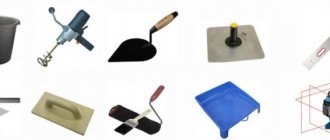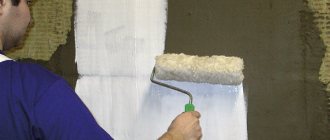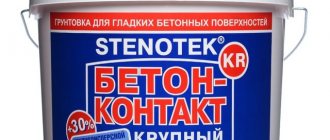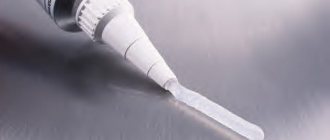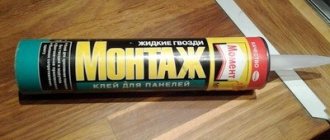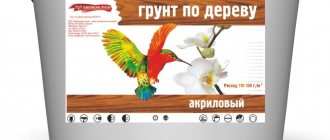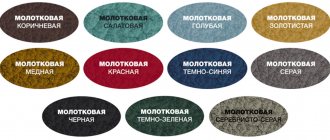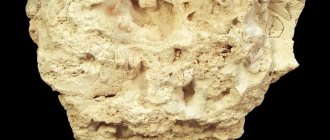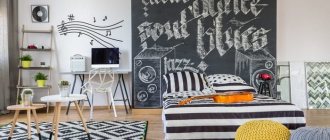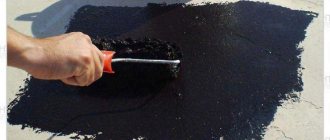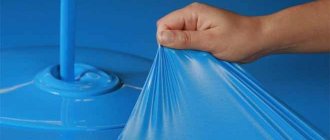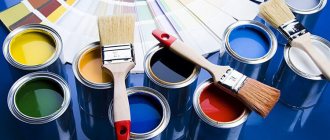"Red ribbon". This is the translation of the German phrase rot band. The Germans combined the concepts, creating one of the Knauf trademarks. Rotband was the name given to a plaster mixture for leveling walls and ceilings. Beige-gray powder. What does the red ribbon have to do with it? The point is in the analogy with the colors of cigar bands. It was conducted by Karl Knauf. To recognize his own products, which were used by men, the entrepreneur chose no less masculine signs. In addition to the rotband, the company began producing gold, blue and green ribbons. The last brand hides a cement-based plaster mixture. What is the basis of the famous rotband and, in fact, why did builders love it so much?
Why is Rotband needed?
In fact, “Rotband” is the trade name of a dry gypsum plaster mixture produced by enterprises of the Knauf group of companies. It is used for internal plastering of the surface of walls and ceilings, their leveling (see → interior decoration). In other words, “Rotband” is needed in order to make the ceiling and walls smooth, suitable for applying finishing - paint, wallpaper or tiles (the similar purpose of Rotband determines its technical characteristics specified in the instructions).
The word Rotband is translated from German as “red ribbon”. In addition to the “Red Tape” itself, Knauf produces or has previously produced “Grunband” (“green tape”; a cement-based plaster mixture), “Goldband” (“golden tape”), “Blauband” (“blue tape”). The founder of the company, Karl Knauf, once proposed designating mixtures in the manner of cigar bands, thus distinguishing individual brands. By the way, the cigar bands themselves were introduced into commercial circulation by Gustave Bock in 1854 at a time of growth in cigar sales for exclusively marketing purposes, allowing one to clearly identify one or another class=”aligncenter” width=”881″ height=”717″[/ img]
History of the Rotband brand
The first products from the Rotband family were produced in West Germany in 1962. Until this point, gypsum mixtures that were used during plastering work were compiled directly on site (at the construction site) without strictly following the recipe (by eye). The main obstacle to the industrial production of ready-made mixtures and their widespread distribution among craftsmen was the fact that gypsum tends to set quickly. It turned out to be possible to overcome this obstacle with the invention of a retardant additive, which was called “Alenal” after its inventor, Mr. Allen. It slowed down the setting process of the mixed mixture, allowing solutions to be mixed in larger quantities and applied more evenly.
Brief history of Knauf
The Knauf Gips KG company itself (until 2003 - Gebr. Knauf Westdeutsche Gipswerke) was founded in 1932 by the brothers Alfons and Karl Knauf (mining engineers). Initially, the factory was located on the banks of the Moselle in the German city of Perl, and the mine was located on the other side of the river in Luxembourg in a place called Schengen. The Knauf company commissioned its first gypsum stone mine in 1938 in a place called Stadtoldendorf (in 1972, the plant in this city began producing plasterboard sheets; Knauf has been producing gypsum boards themselves since 1958). After World War II, it was decided to move the head enterprise to the territory of the American occupation zone, to the city of Iphofen (Lower Franconia in Bavaria), where it is still located. Knauf is a family business that is still owned by members of the founding family. In Russia, Knauf's current activities began in 1993 with participation in the capital of the Thermal Insulation and Gypsum Products Plant (TIGI).
How long does it take for Rotband to dry - technical specifications
The mixture is quite environmentally friendly. The main binder, gypsum, is involved in regulating the microclimate of rooms, if necessary absorbing excess moisture or releasing it. The mixture is mixed with water and is easy to use when installing plastering systems. As a rule, it is applied in one layer, the maximum thickness of which is 30 mm. “Rotband” dries at the rate of “1 day - 1 mm layer”. If we talk about how long it takes to putty the plaster, then this can be done after the specified drying period, the duration of which on average ensures the standard content of residual moisture. When carrying out work on leveling surfaces in several layers, it is recommended to follow the “wet on wet” technology.
The mixture is packaged in paper bags of 5, 10 and 30 kg. You can most often find the latter in stores.
Products sold in Russia are manufactured at enterprises located in the CIS countries. In Moscow, these are, as a rule, products of the Krasnogorsk plant. In addition, on the market of the capital region there are mixtures manufactured at enterprises in St. Petersburg, the Krasnodar Territory or Balti (Moldova) - a list of Knauf enterprises in the CIS. The color of the mixture may differ depending on the characteristics of a particular batch of mineral used in the manufacture of the mixture at a particular plant (gray, pink, white, beige). According to the manufacturer's representatives, color does not affect the quality of the mixture in any way. However, there is a custom among craftsmen to consider, for example, “white” Rotband to be of lower quality (it has greater creep).
| Color | Manufacturer |
| pink | Chelyabinsk, Kolpino (St. Petersburg) |
| white | Kuban, Baskunchak |
| grey | Krasnogorsk (Moscow) |
Currently, there are a considerable number of Rotband analogues of similar quality on the market. Despite this, it still remains a favorite brand among the majority of finishing craftsmen in Russia. As a substitute, mixtures such as “Starateli”, “Osnovit Gipswell”, “Volma-Sloy” can be used.
Instructions for preparing and applying Rotband
During cooking, you should pour the dry mixture into the water, and not vice versa. Failure to comply with this rule will provoke the formation of lumps consisting of undissolved plaster. Do not pour the mixture quickly, this will lead to the same consequences. In the case of Rotband, the situation is not critical, but there are other mixtures for which this is significant. Then use a mixer or drill with a special attachment to mix the composition until a homogeneous mixture is obtained.
Application to the surface is carried out, depending on the chosen plastering method, either with a wide spatula, or, in the case of using beacons, by throwing it on and then removing the excess solution as a rule.
Rotband consumption per 1 m2
Determining this amount is quite simple. The consumption of the mixture per 1 m2 is 8.5 kg for a layer 10 mm thick (see also → consumption of finishing materials). The recommended thickness is 15 mm. This means that such a layer will require 12.75 kg. To be sure, this value should be increased by 10%. Total for plastering 1 sq. m will require 14 kg. Now we multiply this value by the area of work on the installation of plaster systems. We divide the resulting figure by 30 - it is advisable to buy the mixture packaged in 30 kg bags. As a result, we find out the number of bags. Of course, this is a reference calculation that does not take into account the condition of finishing surfaces or the geometry of the premises.
Now you don’t need to manually calculate the mixture - there is a special → Rotband flow calculator
In addition, this calculator offers the ability to simultaneously determine the required quantity and cost of analogue mixtures.
Composition and characteristics
Dry gypsum plaster Rotband is used to level the plane of walls and ceilings in rooms with normal and stable air humidity. The scope of application is determined by the properties of gypsum, which actively absorbs moisture and, when saturated with it, becomes loose, losing strength and adhesion to the surface. This does not allow the use of such mixtures for exterior work or for plastering wet rooms.
Advantages
One of the advantages of this mixture is that the consumption of Rotband per 1 m2 is at least half as much as the consumption of cement-sand plaster with a comparable layer thickness. In addition, it can be used as a finishing layer for wallpapering, tiling or painting.
The fine-grained structure of gypsum plaster allows you to create a smooth surface Source images.by.prom.st
See also: Catalog of companies that specialize in paint, finishing and facade materials.
An important advantage of Rotband, like any other gypsum plaster over other types, is the ability of the layer it creates to regulate the humidity in the room, absorbing its excess and releasing it back if the air becomes very dry.
The basis for applying Rotband can be vertical and horizontal surfaces made of concrete, plasterboard, polystyrene foam, brick and other materials. The adhesive components included in its composition provide strong adhesion even to very smooth surfaces. This is what distinguishes it from the product of the same brand - Goldband plaster, intended exclusively for application to rough and rough surfaces.
Specifications
The manufacturer declares the following product characteristics:
- fraction size from 0.5 to 1.2 mm;
- the thickness of the layer for leveling the ceiling is no more than 15 mm;
- layer thickness for leveling walls up to 50 mm;
- Rotband consumption per 1 m2 with a thickness of 10 mm is 8.5 kg;
- bending strength from 1 MPa;
- compressive strength from 2.5 MPa;
- density of the hardened layer is about 950 kg/sq.m.;
- drying speed 7 days.
The difference between Rotband and Goldband
Although Goldband is so widely available on the market, questions often arise about the difference between the two blends. Rotband contains adhesive components that provide reliable adhesion to the base. They are absent in Goldband. Therefore, in the designation of the Rotband mixture in German there is the word Haft (Haftputz) - adhesion (adhesive plaster), and Goldband is referred to only as Fertigputz - ready-made plaster mixture. Thus, Rotband is intended for application to both rough and smooth surfaces (for example, when plastering a ceiling). Goldband is used to level only rough surfaces that initially provide greater adhesion - brick, itong (a type of gas silicate), foam concrete blocks.
All data is provided without any guarantees or warranties.
Rotband properties
Rotband is based on gypsum powder. Gypsum is a natural mineral. Its hardness is 3 on the Mohs scale with a maximum of 10. This makes it easy to crush stone. In powder, gypsum easily absorbs moisture, that is, it is hygroscopic. Most of the rocks are of sedimentary origin. Sedimentary refers to the gradual subsidence and compaction of sediments at the bottom of reservoirs. Among the sediments there are many remains of living creatures, for example, shells and bones. Their main component is calcium. It also dominates the gypsum formula. Its chemical notation is CaSO4 * 2H2O. Accordingly, gypsum is aqueous calcium sulfate. Pure plaster is white. This is how a rotband turns out.
The plaster may be slightly pinkish or gray. This is not considered a deviation from the standard. There are natural impurities in gypsum. If the mineral mass is purified from mechanical types of sand and clay, then it is impossible to rid the stone of those built into the chemical formula. Considering that the proportion of foreign elements is negligible and does not affect the quality parameters of the plaster with the exception of its color, impurities are left behind. The color of the mixture is not indicated on the packaging of Knauf plaster. The shade can be determined, if this is important, by the place of production. The German company has factories in Russia in Krasnogorsk, Krasnodar Territory, Astrakhan and Chelyabinsk regions. The latter produces pinkish gypsum. Gray is a Krasnogorsk breed. The mineral from the Astrakhan region and Krasnodar region is distinguished by its snow-white color. It is interesting that white and gray mixtures can flow off when applied, that is, they are overly plastic. This gives horizontal waves on the walls.
The phenomenon is explained by the granularity of the gypsum. At the Krasnogorsk and Chelyabinsk deposits, the rock structure contains granules of 0.5 millimeters. In pink deposits there are grains from 1 millimeter. Therefore, gypsum plaster “Knauf-Rotband” from the Krasnodar Territory and the Astrakhan Region is easier to apply, fixes better and goes on smoother. However, the coarse grain of the coating on the walls is a plus if it is a finishing coating. If you need a perfectly smooth surface, for example, under wallpaper, it is better to tinker with the application of a white or gray mixture.
Adding an additional portion of water to gypsum powder turns it into a plaster slurry. It is plastic and sticky. The latter property provides the material with good adhesion, that is, the ability to penetrate into the surfaces being treated. In order to fill every crack in them, rotband gypsum plaster contains polymer additives. These include latexes and a number of resins. The adhesion of the rotband allows it to firmly adhere to plasterboard, concrete, wood and brick bases. On them, Knauf plaster does not shrink or crack. Rotband is a frost-resistant plaster, surviving 75 cycles and serving well on ceilings, corridors, and entrances.
The only problem is the hygroscopicity of the plaster. Gypsum perfectly absorbs moisture not only when mixing the powder, but also during operation. On the one hand, this allows you to control the microclimate in the room. The coating of walls and ceilings absorbs small and temporary excess vapors, releasing them back when the air dries out. However, if the humidity is high and constant, the plaster swells, loses its aesthetics, and is affected by fungi. The hygroscopicity of rotband affects its shelf life. It is 6 months from the date of packaging. During this process, atmospheric air enters the bag with plaster, and with it moisture.
Even an unopened rotband begins to crack on the walls when used after six months. It’s not always the finishers’ fault; sometimes you need to check the packaging date of the plaster. By the way, you need to store it packed and in a dry place. It remains to mention the thermal conductivity of the hero of the article. Finishing material transmits both cold and heat equally poorly. Thermal conductivity is 0.25 watts per meter. In proportion to the indicator of mineral wool - a classic insulation. Considering that the maximum thickness of rotband application is 5 centimeters, plaster can be a help in insulating the room. However, with a minimum layer thickness of 5 millimeters, you don’t have to expect much from the coating.
Walls
0 votes
+
Vote for!
—
Vote against!
Leveling walls with plaster is required in almost every case of major repairs or construction. Plaster often acts as a finishing decorative layer, but most often it serves as a base for wallpaper or tiles. But in any case, its main task is to level the walls and without certain skills it is quite difficult for a beginner to cope with this. The article will discuss the nuances of choosing a high-quality mixture, as well as the sequence of all stages of work.
- Preparation of the composition
Dry mix Rotband
Rotband is a brand of universal dry plaster mixture based on gypsum from the world famous manufacturer Knauf, which produces products of the highest quality. All products are certified and comply with Russian GOST standards and DIN (German Institute for Standardization) standards; they also have all the necessary sanitary and epidemiological conclusions and fire safety certificates. This is especially important for those who care about the health of their family and do not want building materials to have any negative impact in the future.
Application area
Knauf Rotband is a dry plaster based on gypsum with additives that provide increased adhesion. It is recommended for use in rooms with normal humidity, as well as for the kitchen and bathroom. Due to its properties, it can be used on almost any surface of walls and ceilings with a conventional solid base: brick, concrete, cement plaster, polystyrene foam and fiberboard. The manufacturer especially recommends the use of Rotband for smooth concrete surfaces of ceilings and walls.
Technical characteristics of Rotband
- Layer thickness: for walls 5-50 mm, for ceilings 5-15 mm.
- Consumption: about 8.5 kg/m2 (with a layer of 10 mm)
- Amount of water per 30 kg: 18-20 l
- Time to use the finished mortar mixture: 20-25 minutes
- Drying: from 7 days (depending on room conditions)
- The maximum fraction size is no more than 1.2 mm. Strength: compressive >2.5 MPa, and bending >1.0 MPa. Density in solid state is approximately 950 kg/m3.
- Packaging - paper bag with packing of 30, 25, 10 and 5 kg. Shelf life 6 months (if packaging is intact).
Why Rotband?
When choosing plaster, the manufacturer is undoubtedly important, as a guarantee of quality. The Knauf company has already been mentioned; it is known to everyone, even people quite far from construction and repair.
- Rotband has undoubted positive qualities that distinguish it from other gypsum plasters:
- Made from environmentally friendly natural mineral - gypsum, it does not contain any harmful impurities.
- Easy to make and use. Detailed instructions on the packaging of the Rotband dry mixture will help you prepare and apply the plaster yourself. Suitable for both experienced craftsmen and beginners.
- Versatility. Does not require subsequent puttying, as it creates a smooth, even surface suitable for high-quality painting.
- Quick to use. Rotband dries quite quickly (cement plaster dries in about 30 days, gypsum plaster - 7).
- Due to its hygroscopicity, the material “breathes”, providing a favorable climate in the room.
- It has good water-holding ability, does not delaminate or crack even when applied to porous substrates that absorb moisture well.
- Gives freedom of creativity, allows you to create decorative elements, textured surfaces, and also perform restoration work.
Rotband is very popular among contractors performing repair and finishing work due to its practicality and ease of use. However, we cannot fail to mention the shortcomings identified by customers when working with the mixture.
- Price. This plaster is in the middle price range. Its opponents claim that there are plasters on the market with similar qualities, but at a significantly lower price.
- Possible shrinkage of the material. Although this point is still controversial, since shrinkage of the material or cracking can occur due to improper mixing or application technique. The manufacturer claims that its plaster does not crack, even when applied in a thick layer.
Cost of leveling walls with rotband
Before starting repairs, it is worth calculating the cost of leveling the wall with Rotband plaster. The average price of a 30 kg package in Russia is 360 rubles. This amount is enough to plaster 3.5 m2 of surface. Take, for example, a room with a total area of 16 m2. Ceiling height 2.5 m, length 6 m, width 2.7 m. The area of all walls in the room is 43.5 m2. Thus, to plaster a room with a layer of 1 cm, with an average package consumption of 3.5 m2, a little more than 12 packages of Rotband are needed. It is very convenient that the manufacturer packages the mixture not only in large bags, so if a little is not enough, you can buy additional packaging weighing 5 or 10 kg. In total, the cost for a room of 16 m2 will be 4,320 rubles for 12 bags of 30 kg each, plus 200-250 rubles for additional packaging. In this case, only the plaster mixture is calculated, not including tools, primer and additional materials.
How to choose?
So, having decided on the choice of plaster mixture, the only thing left to do is buy it and start working directly. But unfortunately, it's not that simple. Like all popular products, a lot of Rotband fakes appeared. Kanuf has put a lot of effort into identifying and destroying them. To protect its own quality, the manufacturer places a holographic sticker on each package. In addition, you should pay attention to the date of manufacture, which indicates not only the day/month/year, but also the hours, minutes and, most importantly, the seconds of manufacture. A new packet appears on the line every 4-6 seconds, so the time on each packet is unique; if there are two identical ones next to each other, it’s a fake.
Required Tools
To plaster the walls you will need:
- brush or roller for applying primer;
- level or plumb line;
- metal profiles 6 or 10 mm;
- rule;
- spatula (wide);
- construction mixer;
- metal rail;
- hard sponge or metal grater.
Preparing for work
Surface cleaning
First of all, the wall is cleaned of large particles of old plaster, paint, dust and dirt. If concrete bases are plastered, then it is necessary to remove form lubricant from them (in other words, greasy stains, if any). There should be no large unevenness on the surface. Metal elements are pre-treated with anti-corrosion coatings.
Primer
In order for the plaster to adhere well, dry evenly and not deform, the surface must be primed.
The primer is selected based on the type of base. For surfaces that poorly absorb moisture (concrete, cement, expanded polystyrene), a primer of the Knauf Betonkontakt type is selected. For surfaces with high absorbency (brick, aerated concrete), a primer such as Knauf Grundirmittel or Knauf Rotband Grund is required. After application, the primer must be allowed to dry completely and only then proceed to the main work.
Beacons
One of the most important tasks in the preparation process is the installation of beacon profiles, on which plaster will then be applied. Now there are two types on the market: 6 and 10 mm; it is easier for beginners to work with the latter, since they are stiffer. When purchasing, you need to make sure there is no deformation and ensure careful transportation.
Beacons are prepared in advance, they are cut to the required height. To install, Rotband mortar mixture is applied vertically to the surface at a distance of every 30 cm, then beacon profiles are pressed into it and leveled in one plane strictly vertically using a level.
It is better to use the longest possible tool. The remainder of the mixture remaining when pressing the beacon must be evenly distributed along its entire length, filling the resulting gaps between the beacon and the wall.
The distance at which beacons are installed depends on the length of the rule. Ideally, with a rule length of 2 m, the beacons are located 130-180 cm from each other.
Rotband wall leveling technology
Preparation of the composition
Work on plastering surfaces can be carried out in rooms with temperatures from +5 to +30 and with a relative humidity of no more than 60%.
One package weighing 30 kg is diluted with 18 liters of cold water. The water should not be hot, as this may cause the mixture to set too quickly. However, if plastering work is carried out alone, then it is better to prepare a smaller volume, since the composition is applied within 25-30 minutes after its preparation. In this case, a bucket with a volume of 10-15 liters will be enough. It needs to be filled 1/3 with water and gradually introduce the dry mixture. A construction mixer or drill is used for mixing. The thickness of the mass should resemble sour cream. To improve the elasticity of the plaster, it is recommended to leave it for 10 minutes and then mix again.
Tip: during the application process, it is not allowed to add water or dry mixture to the solution, as well as any other components.
Wall application
Professionals apply the mixture with light and relaxed movements, from bottom to top. Beginners are advised to apply the mixture using a wide spatula.
At one time it should be possible to apply plaster in width from one lighthouse to another and in height by about one meter. Then the layer must be leveled using the rule. To do this, the tool is pressed tightly against the beacons and, with zigzag movements, the mixture seems to be pulled upward. Excess plaster formed on the rule is removed either onto the wall or into a bucket for further use.
It is also important to know that since plaster is very plastic, it can settle under its own weight. Therefore, do not be lazy, go through the rule a couple more times from the very bottom in the process of applying plaster to the wall.
If a thicker layer of plaster is required
It so happened that the walls are very uneven and one layer of 10mm is absolutely not enough. In this case, before the first layer has time to harden, it is necessary to walk over it with a plaster comb, which will create a relief.
Allow the layer to dry. Then prime the surface again using Knauf Grundirmittel or Knauf Rotband-Grund, and only after the primer has dried, apply a second coat.
If polystyrene foam or cement surfaces are plastered, then the second layer is applied only to the reinforced mesh.
There are two ways to lay the mesh: on a thin layer of plaster or on PVA glue. In both cases, the mesh is pressed down and smoothed with a spatula until any irregularities or bubbles completely disappear. Then it is sanded a little, excess dust is removed, after which it is primed, dried and a second layer of plaster is applied.
The ceiling is plastered exclusively with one layer, no more than 15 mm thick.
Surface leveling, grouting and smoothing
After approximately 40-50 minutes, the plaster mixture will begin to set; now it needs to be leveled. The excess is cut off with a metal strip and the recesses are filled. In the corners they can be removed using a plaster plane.
The resulting surface is suitable for laying ceramic tiles. The minimum layer of plaster under it is 10 mm.
Grout
Surfaces intended for wallpapering or painting are rubbed with a hard sponge or grater 15 minutes after leveling. To do this, they are moistened generously with water and grouted in a circular motion. This will erase possible unevenness and marks from the spatula after leveling.
You can glue wallpaper onto a wall prepared in this way. However, if you have thin, light wallpaper, then Rotband may show through due to its rather dark shade. In this case, it is better to first apply a layer of finishing putty.
Smoothing
For high-quality painting, you need to achieve a glossy surface. To do this, wait until the wall begins to dry out and becomes matte (about 3-4 hours after mixing the solution), the wall is again moistened abundantly and smoothed with a metal trowel. This surface does not require putty and can be safely painted. Below is a video about leveling walls with a rotband.
Reliefs and bas-reliefs
Gypsum plaster seems to be created for creativity. It is perfect for realizing all your design ideas. In particular, to create an unusual texture on the wall. Relief is given to the plaster using a relief roller or other forming tool.
Creative success and spectacular renovations!
Advantages and disadvantages
Due to the use of gypsum, which is considered an ideal material for the production of plaster mixtures, gypsum leveling coatings acquire a whole set of attractive characteristics, namely:
- environmental safety, since gypsum stone is a pure material of natural origin, excluding the content of impurities that are harmful to human health;
- plasticity, thanks to which the compositions are easily applied and quickly distributed over the working surface. Therefore, not only professional builders, but also those who have just begun to comprehend the intricacies of finishing can work with them;
- provide the creation of a very smooth, pleasant-to-touch surface that does not need additional putty, but can be immediately painted, wallpapered or covered with decorative plaster;
- ability to quickly absorb moisture and release moisture. Rotband actively participates in regulating the humidity conditions in the room and contributes to the formation of a favorable and comfortable microclimate;
- hygiene. The product itself has a porous structure and, accordingly, the ability to drain excess moisture. This coating protects walls and ceilings from mold;
- excellent heat and sound insulation properties;
- high adhesion to substrates made of various materials;
- excellent decorative qualities, which makes textured finishing of wall and ceiling surfaces available;
- eliminate the formation of cracks even when applying a thick layer;
- consumption rates compared to traditional plaster mixtures based on cement and sand are half as low;
- the ability to apply a maximum layer of 5 cm with one plaster coating, excluding preliminary spraying. If necessary, thicker layers can be applied in a couple of approaches;
- versatility in use - the mixtures are suitable for simultaneous plastering with putty, making decor, repair work and restoration activities;
- have a high water-holding capacity, due to which the working solution eliminates delamination, cracking and dehydration when applied to porous substrates that actively absorb liquid, as well as when working at high temperatures;
- fire resistance similar to concrete;
- high drying speed. Compared to cement plaster, which takes a month to dry, a composition with a gypsum base will dry in a week;
- Unlike cement plaster mixtures, Rotband weighs much less, therefore, the load on the treated surfaces will be lower. Due to its light weight, it is easier and cheaper to transport.
Despite the impressive list of advantages and long-term popularity of Rotband plaster mixtures, they also have disadvantages, although quite controversial, since they were identified by users, whose opinions are always subjective.
So, buyers consider several features to be disadvantages.
- High price. Although this plaster is classified as a building material in the mid-price category, according to opponents of this brand, there are many analogues of other brands that have similar performance characteristics, but their purchase is much cheaper.
- Probability of coating shrinkage. Knauf guarantees that its product is resistant to cracking regardless of the thickness of the applied layer. As practice shows, the material shrinks or becomes cracked for three reasons: when the technology for preparing the mortar mixture is violated, the working solution is applied incorrectly, or a fake is encountered.
Today, markets and even large construction stores are replete with low-quality imitations of popular plaster, which contains gypsum, ground sand and added acrylic resin.
Basics of wall preparation and mortar application
Proper preparation of surfaces depends on how firmly the plaster will adhere to the base. It is necessary to thoroughly clean all dirt, rust and foci of biological damage (mold, rot, fungi). Lay a thick plastic film on the floor, securing it with masking tape.
Gypsum plaster is applied according to the same principle as the cement composition. A wide spatula or trowel is used for application. The space between the beacons is filled to a height of about a meter. Next, the solution is leveled using a rule, making zigzag movements from the bottom up and pressing it against the guides. The solution is removed from the tool with a spatula and transferred to areas where it is missing. The rule is to do it 1 or 2 more times, then continue to fill the space.
The plaster solution is applied with a spatula or trowel.
The second trim is done 15-20 minutes after the first procedure to meet higher requirements for surface quality. Irregularities are removed with a wide spatula.
The result of the work depends not only on the quality of the purchased plaster. It is important to prepare the mixture correctly in accordance with the manufacturers' instructions. The quality of the finish is also affected by the accuracy of the craftsman. And unlike professionals, amateurs take much longer to complete the entire process. But experienced masters also started somewhere.
How to distinguish a fake?
Due to the popularity of the Rotband plaster mixture, the market was expectedly overwhelmed by an avalanche of counterfeits. The negative consequences of this phenomenon are the likelihood of discrediting the building material with a subsequent decrease in demand for it. In order to distance itself from low-grade counterfeits, Knauf quickly took measures to protect the reputation of its product.
As a first level of protection, they began to package the plaster in original bags, which are made using corrugated paper, and they are made according to the company’s special order. The second level of protection was the use of second-by-second marking, that is, each bag contains information about the exact time of its production, down to seconds, which eliminates the possibility of the existence of two packages with identical markings. And finally, the presence of a hologram that changes color when rubbed serves as the third level of protection for the originality of Rotband.
A necessary tool.
The entire plastering process involves a lot of work. In addition to the application itself, there is also the preparation of the plane in which brute force often has to be used. Using hammers and chisels to remove humps and bulges from bricks or concrete base. Sanding may be required. Therefore, safety is first and foremost important. Get gloves, construction glasses, and a respirator.
Important: It is better to cut off all the bumps, no matter how difficult it is, otherwise the plaster consumption will be greater, because you will have to add a few millimeters over the entire area.
After stripping the base of paint or wallpaper, you need to check the evenness of the area being treated. To do this, according to the instructions, use a building level or a homemade plumb line in the form of a thread with a load at the bottom. You can secure it with a nail on top. Tie the thread so that it does not touch the application area. Afterwards, simply measure the distances in several places with a ruler.
Covering and leveling is done using hand tools - trowels, spatulas of different sizes and rules. Typically used to work on beacons. In addition to manual application, application can also be mechanized. After completely applying the solution and drying it, you will need grout, which you will use to complete the final leveling. Having prepared for further work on decorating with wallpaper or finishing plaster.
Preliminary work with the base.
Cleaning from previous coating.
The surfaces to be processed are pre-dried, the required temperature is + 5 degrees Celsius. This contributes to less plaster consumption and better application. It is also necessary to clean off the previous coating (whitewash, plaster, paint, tiles or wallpaper). Remove uneven surfaces and protrusions from the base. Be sure to treat metal elements with anti-corrosion liquid. Otherwise, corrosion may appear.
Primer.
- Substrates with increased moisture absorption must be coated with a primer. This is done to ensure uniform adhesion of the plaster to the base. Primer can be applied using brushes, rollers or sprayers. According to the instructions, it is recommended to use Knauf-Grundimittel primer.
- Surfaces that, according to their technical characteristics, do not absorb moisture should be coated with Knauf-Betokontakt primer. This is done to increase adhesion.
Displaying beacons and corners.
Apply Rotband plaster to the wall with gaps of 40 cm. Press the beacons into the moldings and align them in one plane. The leveling rule should be 20 cm longer than the pitch of the beacons. Corner profiles are aligned in the same plane, with the beacons. The moldings are applied to the side inside the profile. Rotband plaster, consumption per 1 m2 with a layer of 10 mm.
- Knauf Rotband plaster – 30 kg; consumption 8.5 kg per 1m2.
- KNAUF-Betokontakt – 30 kg; consumption 0.3 kg per 1m2.
- KNAUF-Grundirmittel – 30 kg; consumption 0.1 kg per 1m2.
You can make detailed expenses using the calculator on the manufacturer KNAUF website.
Subsequence.
Kneading
Pour 18 liters of water into a metal or plastic container and add 30 kg rotband plaster to it. First, put 6 spatulas of the mixture and stir everything until completely mixed, only then pour the entire bag into the water. Mix the entire mixture with a construction mixer until all lumps disappear. The mass should be homogeneous. If the composition is too liquid, add more dry plaster. After mixing everything, you need to wait 5-6 minutes, then stir again. The technical characteristics take a little time to mature.
Application.
Apply the matured mixture to the surface to be treated for 20 minutes. On the ceiling you need to work like a “falcon”, making movements towards yourself. The surface is covered with a spatula. This does not affect consumption, since everything evens out in the future.
Note: If you bought plaster for machine coating, you should use special stations to simplify and automate the process.
After sketching, everything is leveled with a tool - usually making wave-like movements.
When it is necessary to increase the thickness of the coating, repeated layers are applied, having previously created roughness on the first layer. Which will serve to adhere the layers. The second coating can be done only after a day. This is the drying time for rotband plaster.
Leveling and grouting.
The setting period according to the technical specifications is 50 minutes, after which it is leveled with a large spatula or metal lath. Excess is removed by covering up all irregularities. In this way, lower consumption is achieved. The wall for painting or wallpaper is additionally rubbed with a tool - a grater. To do this, they are moistened generously with water and made in a circular motion, this makes the surface perfectly smooth.
Creating a structure.
If relief is needed, it can be easily achieved; to do this, simply on a soft surface (after leveling with the rule), you need to run a roller with a relief on the wheel over it. Structures can also be created using a trowel.
Recommendation: Rotband plaster dries faster if you create a ventilated room. To do this, simply open the windows and doors to allow air to pass through.
Practical use of rotband gypsum mixture
Using ready-made plaster mixture, you can finish almost any building material used for arranging the walls of residential and auxiliary premises. You can plaster brick, concrete, foam block and even polystyrene foam without reducing the strength or quality of the surface. But in each specific case, it will be necessary to take additional measures to improve adhesion to the base of the wall.
The use of gypsum plaster for wall decoration involves the use of other products in combination with rotband. Before applying plaster to brick, foam concrete, or any porous structure, use Knauf Grundiermittel primer; for concrete walls and polystyrene, use Knauf Betokontakt deep penetration composition.
Preparing the walls and applying the base layer of gypsum plaster
Initially, the wall is cleaned of dust and remnants of masonry mortar. To do this, you can use a construction hammer and a dry brush. After cleaning, the stone or concrete surface is primed in accordance with the instructions. After treatment, the surface of the walls dries for at least a day.
At the next stage, the installation of galvanized steel beacons is carried out, along which the surface of the plaster will be leveled. The technique for installing beacons and leveling plaster is well described in the video:
The distance between the beacon strips should not exceed ¾ of the length of the rule. Beacons are attached to a primed wall using a small amount of plaster mixture and leveled using a building level and a stretched line or laser level gauge. In addition, a fishing line or laser will allow you to calculate how much ready-made rotband gypsum mass will be needed for arranging the plaster.
After the wall is prepared, you will need to prepare a gypsum plaster mixture. The most rational way to prepare universal rotband plaster and gypsum finishing material “Knauf” finish is shown in the video:
To prepare the Knauf rotband gypsum mass, you will need a 30-35 liter plastic container, 18 liters of water and one package of dry universal plaster. Typically, the composition for plastering a wall is prepared as follows:
- 30% water and a small amount of dry mixture, 4-5 kg, are added to the container, mixed with a trowel;
- Next, the rest of the water is added to the tub and all the gypsum mass remaining in the bag is poured out;
- Beat the mixture for five minutes using a mixer attachment until creamy;
- The finished plaster mixture sits for another five minutes, and you can begin finishing the walls.
The finished gypsum mass has the consistency of semi-liquid sour cream; it is scooped onto a spatula in portions of 400-500 grams and forcefully thrown onto the wall in rows from bottom to top.
Advice! Considering the fact that the plaster dries quite quickly, the gypsum mass is prepared exactly as much as will fit on a strip 1 m wide and 2.5 m high.
In order to calculate how much mixture is required for plastering a wall, use the following ratio: for plaster 10 mm thick, prepared from a 30 kg bag, the plaster mass is enough for 3.1-3.3 m2. The manufacturer recommends applying gypsum plaster with a thickness of 5 to 25 mm. In practice, the rotband held up perfectly on the walls even with a layer thickness of 1 to 40 mm.
Immediately after finishing throwing the plaster mixture onto the wall, using an H-shaped rule, the mixture is pulled up and at the same time leveled along the installed beacons. The planks should not protrude onto the surface of the plaster, otherwise the wall will become ribbed after drying.
If it is difficult to work with beacons, you can refuse to use them altogether, as in the video:
The quality will be slightly lower, but you can finish almost any surface with rotband. In this case, corner mesh profiles made of plastic or aluminum installed at the corners of the walls are used as beacons. Laying technology without the use of beacons is a little more complicated and requires good visual memory.
Initially, a rough layer of Knauf plaster is laid on the wall, after which the rule is to measure and look for depressions on the treated surface. With the second layer, the defects are rubbed with a rotband, and the excess is removed using the rule. On the third layer, the plaster is smoothed with your own hands in the usual manner.
Leveling and filling the applied plaster
Approximately 15 minutes after the first treatment with the rule, the rotband plaster dries, stops floating down, and it can be leveled with a fine trapezoidal rule or a wide trowel.
After the surface has become smooth, but slightly rough, they proceed to smoothing the Knauf Rotband plaster with a dense sponge material glued to the sole of the trowel. After this treatment, the surface becomes soft and is additionally polished with a wide spatula. The polished layer dries for 20-24 hours at room temperature. In extreme cases, at a minimum temperature of 5°C, the rotband material dries for several days. On such a wall you can glue wallpaper yourself or apply decorative plaster.
After drying, the wall is additionally treated with Knauf Grundiermittel primer, which dries for at least another 10 hours.
The finishing composition for finishing is prepared using the same method as the universal gypsum “Knauf”. Initially, add a small amount of the finishing mixture to a container of water with your own hands, as determined by the instructions. There should be a small amount of water left on the mirror. The poured dry mixture with water is left for 5-10 minutes so that the gypsum is saturated and watered with water. Next, the mixture is broken with your own hands for 5 minutes until it becomes creamy, after which it is kept for another 5-10 minutes to stabilize the mixture. The finished mixture contains substances that prevent the mixture from separating and separating its individual components. Such substances dissolve in water much worse than ordinary gypsum or surfactants, so it is advisable to pause before mixing so that all components of the rotband dissolve evenly.
The procedure for applying the Knauf finishing compound to the wall is similar to the scheme for working with the first sublayer. After completion, the plaster material is allowed to dry and also sanded with a wide stainless steel spatula.
What are the most common mistakes when plastering walls?
What is important to pay attention to when performing plastering work so that the surface is durable and gives the interior a beautiful appearance? The answer lies in following the instructions for using rotband plaster, choosing the appropriate materials and accuracy when performing plastering work.
What mistakes are most often made when carrying out plastering work?
- work at low temperatures – below + 5 °C;
- applying the solution to wet surfaces, especially reinforced concrete - the maximum permissible residual moisture should not exceed 3%;
- applying rotband in two layers - all gypsum solutions are single-layer;
- insufficient preparation of the base - lack of primer, use of primers that are not recommended by manufacturers, lack of Knauf Profix reinforcing mesh;
- applying a solution of too small a thickness;
- making a surface that is too smooth creates a glassy microstructure that closes the pores of the plaster, which in practice leads to a very long drying time - up to 6 months, difficulty in painting such a surface, for example, the roller slipping and poor adhesion to the paint, and loss of properties for regulating the microclimate in the room.
The presented technology concerns the implementation of smooth plaster, which is the basis for painting, installing tiles or gluing wallpaper. If we want to get a certain texture on the wall, we should abandon smoothing. In this case, the plaster is applied in a different way, for example, by pressing a spatula into fresh plaster mortar on the wall, etc.
Instructions for use
During finishing work, you must read the instructions for using Knauf dry building mixtures (usually such information is indicated on the packaging).
To carry out high-quality plastering work, we will need the following tools:
- drill with attachment;
- building level;
- container for mixing the solution;
- putty knife;
- rule;
- metal beacons;
- sponge of increased rigidity.
At the preparatory stage of work, it is necessary to clean the base from the remnants of the old coating. Exposed pieces of reinforcement are coated with paint or other anti-corrosion compounds. Next, a deep penetration primer is applied to the surface of the walls, which will promote better adhesion of the plaster and the base surface.
At the next stage, we proceed to installing beacons. It is these elements that regulate the thickness of the plaster layer. The guides can have a width of 6 or 10 millimeters; they are brought to the required length by trimming. Next, the beacons are installed using a laser level in one plane. These elements are securely fixed to the wall surface using gypsum plaster. After the solution has dried, the gaps between the guides are filled with the prepared mixture.
See also: Non-woven wallpaper - varieties and care rules
How to prepare a working mixture
The solution should be prepared according to the manufacturer's recommendations (instructions are indicated on the packaging). For large volumes of work, a bag of dry mixture with a capacity of 30 kilograms is thoroughly mixed with 18 liters of water. The plaster is mixed with a mixer to a uniform consistency. It is important not to use hot water, because such liquid will speed up the setting process of the solution.
If the volume of work is small, you can use a small container, for example a 15 liter bucket, to prepare the plaster. It is filled one third with water, after which Rotband is added. During the mixing process, the solution should acquire a creamy consistency.
After 10 minutes, the solution is stirred again. This allows you to improve elasticity.
Tips and tricks
Experts recommend following a few simple rules when working with Knauf Rotband gypsum plaster.
- When you plan to glue trellises in white or light pastel colors, it is better to treat the plastered walls before gluing them with a white finishing putty.
- To give the walls or ceiling a spectacular gloss, the applied working solution is thoroughly moistened after 3–3.5 hours, and then smoothed with a wide spatula or grater. The advantage of this procedure is that there is no need to putty Rotband, since the surface prepared in this way can be painted.
- This leveling finishing coating can be used as a starting putty due to its high strength properties and excellent adhesive ability. However, Rotband as a putty is compatible only with finishing compounds with a gypsum binder base.
- To obtain a structural surface proceed as follows. First, level the plaster using a rule, and then, without waiting for the layer to set, use a relief roller. To create a structure over the plaster layer, you can also use a brush with stiff bristles or grout
- Upon completion of the finishing work, in order for the plaster to dry faster, the room must be ventilated.
- The Rotband plaster composition, known for its high adhesive properties, adheres perfectly to everything it comes into contact with. Therefore, after completing the work, you cannot put off washing the tools “for later.” If you don’t do this right away, then you won’t be able to get rid of the dirt with water, but will have to remove it mechanically, spending a lot of time and effort scraping off the stuck solution.
- Experienced plasterers always keep a bucket of water ready to wash the mixer. Each time, after mixing the solution, the spiral attachment is left in the drill, dipped in a bucket of water and washed with the drill turned on, which is very convenient.
- In construction, at the stage of rough work, craftsmen often use process water, and if there is no water supply at the site, they use well water or collect it from the nearest reservoir.
It is extremely important to dilute dry plaster mixtures with clean running water, since as a result of its stagnation, a favorable environment is formed for the proliferation of microorganisms that can provoke the development of mold on plastered surfaces.
Instructions and rules for working with plaster
The procedure for working with the Rotband gypsum mixture, including a set of rules, is no different from using gypsum-based solutions from other manufacturers. The sequential operations look like this:
| Preparing the base. | |
| Padding. | |
| Installation of beacon profiles. | |
| Preparation of the mixture. | |
| Application and leveling of the composition (trimming). | |
| Second trim (for high-quality plaster). | |
| "Dismantling" of beacons made of plaster coating. | |
| Grouting the plaster surface. | |
| Relief formation. |
The drying time of the mixture is affected by the temperature and humidity of the room.
The technology for working with Rotband plaster is simple and can be done by any novice craftsman.
